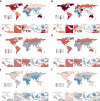Global, regional, and national burdens of eating disorders from 1990 to 2021 and projection to 2035
- PMID: 40860478
- PMCID: PMC12375436
- DOI: 10.3389/fnut.2025.1595390
Global, regional, and national burdens of eating disorders from 1990 to 2021 and projection to 2035
Abstract
Background: Eating disorders severely impact the physical and mental health and challenge global healthcare. This study examined global trends in incidence, mortality, and disability-adjusted life years (DALYs) related to eating disorders from 1990 to 2021 and projected the burden to 2035.
Methods: Data from Global Burden of Disease (GBD) 2021 were used to calculate mortality, incidence, and DALYs rates. Analyses were stratified by age, sex, disorder type, and region. Frontier analysis quantified the gap between current and minimum achievable burdens. Decomposition analysis assessed population growth, aging, and epidemiological transitions. Health inequalities were studied using inequality indices. Future trends were predicted using Bayesian Age-Period-Cohort (BAPC) modeling.
Results: The age-standardized DALYs rate for eating disorders increased from 37.33 (95% UI: 22.67-58.60) to 43.36 per 100,000 (95% UI: 26.35-68.45), and the age-standardized incidence rate (ASIR) rose from 106.78 (95% UI: 74.30-150.89) to 124.4 per 100,000 (95% UI: 86.48-175.74). The age-standardized DALYs rate (EAPC = 0.67) and ASIR (EAPC = 0.55) increased at faster annual rates for bulimia nervosa than for anorexia nervosa. In 2021, the highest age-standardized death rate (ASDR) were recorded in Central Europe, the largest age-standardized DALYs rate were documented in Western Europe, and the greatest ASIR were reported in Andean Latin America. High sociodemographic index (SDI) regions bore the greatest burden. We also found that Females, particularly aged 15-24, experienced higher burdens. Decomposition analysis underscored the variations in the drivers of disease burden across different SDI regions. Analysis of health inequality showed that the disparity in disease burden attributable to economic factors has further widened. BAPC modeling predicted continued burden growth.
Conclusion: The disease burden imposed by eating disorders is gradually increasing, especially impacting women, youth, and young adults, and more so in regions with a high SDI index. Projections indicate that by 2035, this burden will still be substantial. Health inequalities due to the wealth gap have become more severe. These findings can guide targeted strategies for prevention and control.
Plain english summary: This is the first study to use the GBD 2021 data to provide a comprehensive in-depth study of the global, regional, and national burdens of eating disorders between 1990 and 2021. In this study, we explored the deeper drivers of the disease burden using frontier, decomposition, and health inequality analyses, in addition to describing the burden of mortality, morbidity, and DALYs in eating disorders. Potential trends through 2035 were also projected using BAPC modeling. We found that the disease burden imposed by eating disorders was gradually increasing. Health inequalities due to the wealth gap had become more severe. This study offered the most current and comprehensive global assessment of the burden of eating disorders, providing critical and updated evidence for healthcare professionals, public health practitioners, and policymakers worldwide. Emphasizing the holistic treatment of mental and physical health, and fostering global collaboration and data sharing were critical for advancing the study and prevention of eating disorders.
Keywords: anorexia nervosa; bulimia nervosa; disability-adjusted life years; eating disorder; global burden of disease; incidence; mortality.
Copyright © 2025 Liu, Liu, Yu, Yang, Liu, Yu, Qin and Liu.
Conflict of interest statement
The authors declare that the research was conducted in the absence of any commercial or financial relationships that could be construed as a potential conflict of interest.
Figures










Similar articles
-
Burden of knee osteoarthritis in China and globally: 1990-2045.BMC Musculoskelet Disord. 2025 Jul 1;26(1):582. doi: 10.1186/s12891-025-08858-8. BMC Musculoskelet Disord. 2025. PMID: 40598022 Free PMC article.
-
Global impact of dietary risks on cancers: burdens across regions from 1990 to 2021 and the projection to 2035.Front Nutr. 2025 Jul 4;12:1585305. doi: 10.3389/fnut.2025.1585305. eCollection 2025. Front Nutr. 2025. PMID: 40686816 Free PMC article.
-
Global, regional, and national burden of maternal disorders, 1990-2021: a systematic analysis from the global burden of disease study 2021.BMC Public Health. 2025 Jul 29;25(1):2576. doi: 10.1186/s12889-025-23814-w. BMC Public Health. 2025. PMID: 40730990 Free PMC article.
-
National and subnational burden of brain and central nervous system cancers in China and global from 1990 to 2021: results from the global burden of disease study 2021.Arch Public Health. 2025 Jul 28;83(1):195. doi: 10.1186/s13690-025-01683-4. Arch Public Health. 2025. PMID: 40722045 Free PMC article.
-
The disease burden of ILD at the global, regional, and national levels from 1990 to 2021, and projections until 2035: the 2021 Global Burden of Disease study.Front Med (Lausanne). 2025 Aug 13;12:1637654. doi: 10.3389/fmed.2025.1637654. eCollection 2025. Front Med (Lausanne). 2025. PMID: 40880770 Free PMC article.
References
-
- Natoli A, Allen L, Ashton C, Lamba N, Marek R. Measuring eating behavior and motivations in the United Arab Emirates and the United States: Evaluating measurement and predictive invariance of the eating disorder examination questionnaire-short form and the eating motivation survey. Psychol Assess. (2024) 37:62–9. 10.1037/pas0001352 - DOI - PubMed
LinkOut - more resources
Full Text Sources
Miscellaneous

